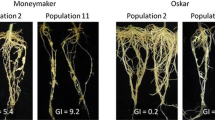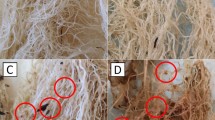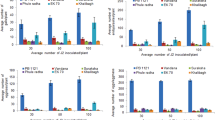Abstract
Experiments were conducted to determine the effectiveness and profitability of the Mi-resistance gene in tomato in suppressing populations of Meloidogyne javanica in a plastic-house with a natural infestation of the nematode. Experiments were also conducted to test for virulence and durability of the resistance. Monika (Mi-gene resistant) and Durinta (susceptible) tomato cultivars were cropped for three consecutive seasons in non-fumigated or in soil fumigated with methyl bromide at 75 g m−2 and at a cost of 2.44 euros m−2. Nematode densities were determined at the beginning and end of each crop. Yield was assessed in eight plants per plot weekly for 6 weeks. The P f/P i values were 0.28 and 21.6 after three crops of resistant or susceptible cultivars, respectively. Growth of resistant as opposed to susceptible tomato cultivars in non-fumigated soil increased profits by 30,000 euros ha−1. The resistant Monika in non-fumigated soil yielded similarly (P > 0.05) to the susceptible Durinta in methyl bromide fumigated soil but the resistant tomato provided a benefit of 8800 euros ha−1 over the susceptible one because of the cost of fumigation. Selection for virulence did not occur, although the nematode population subjected to the resistant cultivar for three consecutive seasons produced four times more eggs than the population on the susceptible one. Such a difference was also shown when the resistant cultivar was subjected to high continuous inoculum pressure for 14 weeks. The Mi-resistance gene can be an effective and economic alternative to methyl bromide in plastic-houses infested with root-knot nematodes, but should be used in an integrated management context to preserve its durability and prevent the selection of virulent populations due to variability in isolate reproduction and environmental conditions.
Similar content being viewed by others
References
O Busquets FJ Sorribas S Verdejo-Lucas (1994) ArticleTitlePotencial reproductor del nematodo Meloidogyne en cultivos hortícolas Investigación Agraria: Producción y Protección Vegetal 9 1–7
P Castagnone-Sereno M Bongiovanni A Dalmasso (1993) ArticleTitleStable virulence against tomato resistance Mi gene in the parthenogenetic root-knot nematode Meloidogyne incognita Phytopathology 83 803–805
VH Dropkin (1969) ArticleTitleThe necrotic reaction of tomatoes and other hosts resistant to Meloidogyne: Reversal by temperature Phytopathology 59 1632–1637
M Eddaoudi M Ammati A Rammah (1997) ArticleTitleIdentification of resistance breaking populations of Meloidogyne on tomatoes in Morocco and their effect on new sources of resistance Fundamental and Applied Nematology 20 285–289
D Esmenjaud CS La Massèse G Salesses JC Minot R Voisin (1992) ArticleTitleMethod and criteria to evaluate resistance to Meloidogyne arenaria in Prunus cerasifera Her Fundamental and Applied Nematology 15 385–389
D Esmenjaud JC Minot R Voisin (1996) ArticleTitleEffects of durable inoculum pressure and high temperature on root galling, nematode numbers and survival of Myrobalan plum genotypes (Prunus cerasifera Her) highly resistant to Meloidogyne spp Fundamental and Applied Nematology 19 85–90
Hanna HY, Colyer PD, Kirkpatrick TL, Romaine DJ and Vernon PR (1993) Improving yield of cucumbers in nematode infested soil by double-cropping with a resistant tomato cultivar, using transplants and nematicides. Proceedings of the Florida State Horticultural Society 106: 163–165
P Holliday (1989) A Dictionary of Plant Pathology. Cambridge University Press Cambridge, UK
RS Hussey KR Barker (1973) ArticleTitleA comparison of methods of collecting inocula of Meloidogyne spp. including a new technique. Plant Disease 57 1025–1028
H Jarquin-Barberena A Dalmasso G de Guiran M Cardin (1991) ArticleTitleAcquired virulence in the plant parasitic nematode Meloidogyne incognita. 1. Biological analysis of the phenomenon. Revue de Nématologie 14 261–275
YX Jiang G Nombela M Muñíz (2001) ArticleTitleAnalysis by DC-EPG of the resistance to Bemisia tabaci on an Mi-tomato line Entomologia Experimentalis et Applicata 99 259–302
Methyl Bromide Technical Options Committee (2002) 2002 Report of the methyl bromide technical options committee. United Nations Environment Program. Ozone Secretariat. Nairobi, Kenya
C Netscher (1976) ArticleTitleObservations and preliminary studies on the occurrence of resistance breaking biotypes of Meloidogyne spp. on tomato. Cahier ORSTOM Série Biologie 11 173–178
JW Noling (2000) ArticleTitleEffects of continuous culture of a resistant tomato cultivar on Meloidogyne incognita soil population density and pathogenicity Journal of Nematology 32 452
G Nombela F Beitia M Muñíz (2001) ArticleTitleA differential interaction study of Bemisia tabaci Q-biotype on commercial tomato varieties with or without the Mi resistance gene, and comparative host responses with the B-biotype Entomologia Experimentalis et Applicata 98 339–344
JL Ogallo PB Goodell JW Eckert PA Roberts (1999) ArticleTitleManagement of root-knot nematodes with resistant cotton cv NemX. Crop Science 39 418–421 Occurrence Handle10.2135/cropsci1999.0011183X0039000200020x
C Ornat S Verdejo-Lucas (1999) ArticleTitleDistribución y densidades de población de Meloidogyne spp. en cultivos hortícolas de la comarca de El Maresme (Barcelona). Investigación Agraria: Producción y Protección Vegetal 14 191–201
C Ornat S Verdejo-Lucas FJ Sorribas (1997) ArticleTitleEffect of the previous crop on population densities of Meloidogyne javanica and yield of cucumber Nematropica 27 85–90
C Ornat S Verdejo-Lucas FJ Sorribas (2001) ArticleTitleA population of Meloidogyne javanica in Spain virulent to the Mi resistance gene in tomato Plant Disease 85 271–276
Pedigo (1989) Entomology and Pest Management. Macmillan New York, USA
J Philis (1983) ArticleTitleOccurrence of Meloidogyne spp. and races on the island of Cyprus. Nematologia Mediterranea 11 13–19
J Philis N Vakis (1977) ArticleTitleResistance of tomato varieties to the root-knot nematode Meloidogyne javanica in Cyprus Nematologia Mediterranea 5 39–44
JC Prot (1984) ArticleTitleA naturally occurring resistance breaking biotype of Meloidogyne arenaria on tomato. Reproduction and pathogenicity on tomato cultivars Roma and Rossol. Revue de Nématologie 7 23–28
JR Rich SM Olson (1999) ArticleTitleUtility of Mi gene resistance in tomato to manage Meloidogyne javanica in North Florida Journal of Nematology 31 715–718 Occurrence Handle1:STN:280:DC%2BD1M7psVCisg%3D%3D Occurrence Handle19270941
PA Roberts (1995) ArticleTitleConceptual and practical aspects of variability in root-knot nematodes related to host plant resistance Annual Review of Phytopathology 33 199–221 Occurrence Handle1:CAS:528:DyaK2MXosFWisLw%3D Occurrence Handle18999959
PA Roberts (2002) Concepts and consequences of resistance. JL Starr R Cook J Bridge (Eds) Plant Resistance to Parasitic Nematodes CABI Publishing Wallingford, UK 23–41
PA Roberts IJ Thomason (1989) ArticleTitleA review of variability in four Meloidogyne spp. measured by reproduction on several hosts including Lycopersicon. Agricultural Zoology Reviews 3 225–252
Rossi M, Goggin FL, Milligan SB, Kaloshian I, Ullman DE and Williamson VM (1998) The nematode resistance gene Mi of tomato confers resistance against the potato aphid. Proceedings of the National Academy of Sciences USA 95: 9750–9754
Smith PG (1944) Embryo culture of a tomato species hybrid. Proceedings of the American Society of Horticultural Science 44: 413–416
FJ Sorribas S Verdejo-Lucas (1994) ArticleTitleSurvey of Meloidogyne spp. in tomato production fields of Baix Llobregat county, Spain. Journal of Nematology 26 731–736 Occurrence Handle1:STN:280:DC%2BD1M3gt1Khsg%3D%3D Occurrence Handle19279955
FJ Sorribas S Verdejo-Lucas (1999) ArticleTitleCapacidad parasitaria de Meloidogyne spp. en cultivares de tomate resistentes. Investigación Agraria: Producción y Protección Vegetal 14 237–247
JL Starr J Bridge R Cook (2002) Resistance to plant-parasitic nematodes: History, current use and future potential. JL Starr R Cook J Bridge (Eds) Plant Resistance to Parasitic Nematodes CABI Publishing Wallingford, UK 1–22
EA Tzortzakakis SR Gowen (1996) ArticleTitleOccurrence of a resistance-breaking pathotype of Meloidogyne javanica on tomatoes in Crete, Greece Fundamental and Applied Nematology 19 283–288
EA Tzortzakakis DL Trudgill MS Phillips (1998) ArticleTitleEvidence for a dosage effect of the Mi gene on partially virulent isolates of Meloidogyne javanica Journal of Nematology 30 76–80 Occurrence Handle1:STN:280:DC%2BD1M7pslKltA%3D%3D Occurrence Handle19274201
S Verdejo-Lucas C Ornat FJ Sorribas A Stchigel (2002) ArticleTitleSpecies of root-knot nematodes and fungal egg parasites recovered from vegetables in Almería and Barcelona, Spain Journal of Nematology 34 405–408 Occurrence Handle1:STN:280:DC%2BD1M7ovFGqtQ%3D%3D Occurrence Handle19265964
S Verdejo-Lucas FJ Sorribas C Ornat M Galeano (2003) ArticleTitleEvaluating Pochonia chlamydosporia in a double-cropping system of lettuce and tomato in plastic houses infested with Meloidogyne javanica Plant Pathology 52 521–528
AG Whitehead JR Hemming (1965) ArticleTitleA comparison of some quantitative methods of extracting small vermiform nematodes from soil Annals of Applied Biology 55 25–38 Occurrence Handle10.1111/j.1744-7348.1965.tb07864.x
VM Williamson (1988) ArticleTitleRoot-knot nematode resistance genes in tomato and their potential for future use Annual Review Phytopathology 36 277–293
WM Zeck (1971) ArticleTitleA rating scheme for field evaluation of root-knot nematode infestations Pflanzenschtz-Nachrichten Bayer 24 141–144
Author information
Authors and Affiliations
Corresponding author
Rights and permissions
About this article
Cite this article
Sorribas, F.J., Ornat, C., Verdejo-Lucas, S. et al. Effectiveness and profitability of the Mi-resistant tomatoes to control root-knot nematodes. Eur J Plant Pathol 111, 29–38 (2005). https://doi.org/10.1007/s10658-004-1982-x
Accepted:
Issue Date:
DOI: https://doi.org/10.1007/s10658-004-1982-x




